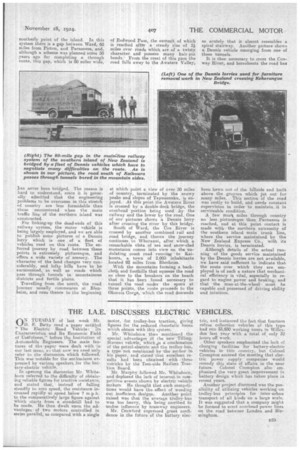THE I.A.E. DISCUSSES ELECTRIC VEHICLES.
Page 9

If you've noticed an error in this article please click here to report it so we can fix it.
ON TUESDAY of last week Mr. D E. Ratty read a paper entitled The Electric Road 'Vehicle: Its Characteristics and Its Economic Field . of Usefulness," before the Institution of Automobile Engineers. The main features of the paper were dealt with in our last. issue' sa that now we reed only refer to the discussionwhich followed. This was notable for the enthusiasm expressed by various speakers for the battoy-electric vehicle.
In opening the discussion Mr. Whitehorn referred to the difficulty of obtain. lug reliable figures for tractive ieeistance, and stated that, instead of falling steadily to veto speed, the resistance increased rapidly at speed below 7 m.p.h. to the comparatively large figure against which starts from a standstill had to be made. He then dwelt upon the advantages of two motors controlled in series parallel, as compared with a single motor, for trolley-bus traction, giving figures for the reduced rheostatic 106Seti which obtain with this system.
Mr. Whitchocn then mentioned the special, advantages 6f the new TillingStevens vehicle, whichajs a combination of the petrol-electric and the trolley-bus, a type not mentioned by the author in his paper, and stated that excellent results had been obtained with these vehicle's by the Tees-side Raillees Traction Board.
Mr. Murphy followed Mr. Whitehorn, and deplored the lack of interest in competitive events shown by electric vehicle makers. He thought that such cenipetitio-ns would have the effect of weeding
out inefficient designs. Another point raised was that the average tiolley-bus was too heavy, this being ascribed to undue influence by tramway engineers.
Mr. Crawford expressed great confidence in the future of the battery elec
tric, and instanced the fact that fourteen refuse collection vehicles of this typo had run 33,830 working nours in Willesden last year with a total of only 32 hours off work.
Other speakers emphasized the lack of charging facilities for battery-electric vehicles in this country, but Colonel Crompton assiired the meeting that electric power supply companies would remedy this state of affairs in the near future. Colonel Crompton aTso emphasized the very great improvement in battery design which has taken place in recent years. Another project discussed was the possibility of utilizing vehicles working on trolley-bus principles for • inter-urban transport. of all kinds on a large scale. It. was suggested that a company might be formed to erect overhead power lines on the road between London and Birmingham.
































